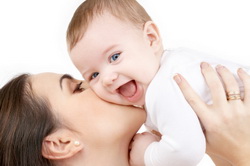If regular IVF technique fails to result in pregnancy, IVF donor eggs become an alternative. But let us first consider what usually happens in conventional IVF technique.

In typical in vitro fertilization (IVF), a woman's ovary is stimulated to produce sufficient number of egg cells. These are retrieved and combined with her partner's sperm cells placed in a laboratory dish and kept inside an IVF incubator for fertilization. After which, the fertilized embryo is then transferred into the woman's uterus hoping to result to pregnancy. IVF procedure rarely results into pregnancy during the first cycle. This means that the procedure may be repeated till pregnancy occurs.
If pregnancy is not achieved even after several repetitions, then IVF donor procedure is recommended. Studies show that around 3,000 babies were born from IVF donor eggs. Egg donation procedure was introduced in 1982 when the first successful birth was reported. Embryo transfer is now done throughout the world using donor eggs. Research reveals that the success rate of IVF donor egg procedure is around 55 percent.
Who will be treated with IVF donor eggs procedure?
Ovum or oocyte donation is another term used for egg donation, which was proven as the finest solution for infertility issues among women. However, this procedure is not recommended for women whose infertility problem is due to anatomical issues of the uterus like serious intrauterine adhesions. The procedure is commonly used in women whose ovarian reserve and the number of eggs and quality are poor. It is also recommended to women who are in advanced age who want to get pregnant as well as to those with poor response to ovarian stimulation.
How are IVF donor procedure and timing done?
The entire process of IVF donor procedure is similar to conventional IVF procedure except that the eggs came from a donor. The infertile couple will carefully choose the egg donor who will undergo comprehensive screening for any hereditary health conditions and infectious diseases. The good thing about this procedure is that you get the chance to choose your donor or settle for anonymous donors. Once you've chosen your egg donor, both parties will sign a consent agreement and the egg donor is then stimulated to produce multiple egg cells. After which, the infertile recipient will be subjected to medications such as estrogen pills or patches to stir development of the uterine lining and Lupron to suppress of her menstrual cycle.
Preparing the Recipient's Uterine Lining
Proper timing in transferring the fertilized embryo from egg donor onto the recipient's uterine lining is very critical for successful implantation and pregnancy. This is often accomplished by delicately controlling the start of hormonal (estrogen) medication of the recipient. The desired thickness of the uterine lining of the recipient is over 8mm for successful implantation.
IVF donor eggs procedure is really expensive. That is why you need to select your egg donor carefully. The selection process can be very emotional with mix feelings of sadness and excitement. Besides, finding the right donor is very challenging and overwhelming. However, you are willing to go through all of these just to have and hold your baby in your arms.
